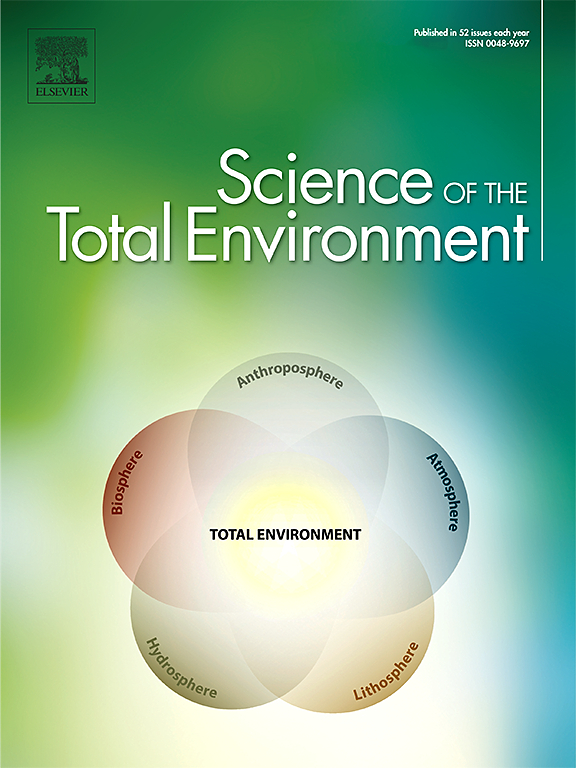Toxicological insights into graphene family materials: Cytochrome P450 modulation and cellular stress in liver cells
IF 8
1区 环境科学与生态学
Q1 ENVIRONMENTAL SCIENCES
引用次数: 0
Abstract
Graphene family materials (GFM), including pristine graphene (GN), graphene oxide (GO), and nano-sized graphene oxide (nGO), are increasingly utilized across industrial, environmental, and biomedical domains. Despite their potential benefits, the hazardous effects of GFM, particularly on liver xenobiotic-metabolizing enzymes and cellular functions, are not fully understood. Cytochrome P450 (CYP) are enzymes conserved across species, which play a crucial role in the metabolism of xenobiotics, drugs, environmental pollutants, and endogenous compounds, are key to understanding the biotransformation and detoxification processes impacted by GFM. This study investigates the effects of GFMs on CYP enzymes (CYP1A2, CYP2D6, CYP3A4) in a recombinant CYP system and HepG2 liver cells, alongside an assessment of cellular stress responses. In HepG2 cells, GFMs induced oxidative stress, mitochondrial depolarization, and cytotoxicity, with GN causing the most pronounced effects. GO exhibited the strongest inhibition of CYP enzymatic activity, particularly CYP1A2, in a dose-dependent manner in a recombinant CYP system. None of the tested nanomaterials significantly altered CYP expression, except for nGO, where a slight increase in CYP3A4 protein expression was observed. These findings highlight the significant influence of GFM physicochemical properties on their hazardous potential, especially their ability to disrupt metabolic processes and induce cellular stress. This study emphasizes the critical need for evaluating the safety of GFM in light of their widespread application and potential environmental and human health implications.

石墨烯家族材料的毒理学见解:肝细胞中的细胞色素P450调节和细胞应激
石墨烯族材料(GFM),包括原始石墨烯(GN)、氧化石墨烯(GO)和纳米级氧化石墨烯(nGO),在工业、环境和生物医学领域的应用日益广泛。尽管 GFM 具有潜在的益处,但其有害影响,尤其是对肝脏异生物代谢酶和细胞功能的影响,尚未得到充分了解。细胞色素 P450(CYP)是跨物种保守的酶,在异生物、药物、环境污染物和内源性化合物的代谢过程中发挥着至关重要的作用,是了解受 GFM 影响的生物转化和解毒过程的关键。本研究调查了 GFM 在重组 CYP 系统和 HepG2 肝细胞中对 CYP 酶(CYP1A2、CYP2D6、CYP3A4)的影响,同时评估了细胞应激反应。在 HepG2 细胞中,GFMs 可诱导氧化应激、线粒体去极化和细胞毒性,其中 GN 的影响最为明显。在重组 CYP 系统中,GO 对 CYP 酶活性的抑制作用最强,尤其是对 CYP1A2 的抑制作用,且呈剂量依赖性。所测试的纳米材料都没有明显改变 CYP 的表达,只有 nGO 除外,其 CYP3A4 蛋白表达略有增加。这些发现突显了 GFM 的物理化学特性对其危害潜力的重大影响,尤其是其破坏代谢过程和诱导细胞应激的能力。这项研究强调,鉴于 GFM 的广泛应用及其对环境和人类健康的潜在影响,亟需对其安全性进行评估。
本文章由计算机程序翻译,如有差异,请以英文原文为准。
求助全文
约1分钟内获得全文
求助全文
来源期刊

Science of the Total Environment
环境科学-环境科学
CiteScore
17.60
自引率
10.20%
发文量
8726
审稿时长
2.4 months
期刊介绍:
The Science of the Total Environment is an international journal dedicated to scientific research on the environment and its interaction with humanity. It covers a wide range of disciplines and seeks to publish innovative, hypothesis-driven, and impactful research that explores the entire environment, including the atmosphere, lithosphere, hydrosphere, biosphere, and anthroposphere.
The journal's updated Aims & Scope emphasizes the importance of interdisciplinary environmental research with broad impact. Priority is given to studies that advance fundamental understanding and explore the interconnectedness of multiple environmental spheres. Field studies are preferred, while laboratory experiments must demonstrate significant methodological advancements or mechanistic insights with direct relevance to the environment.
 求助内容:
求助内容: 应助结果提醒方式:
应助结果提醒方式:


